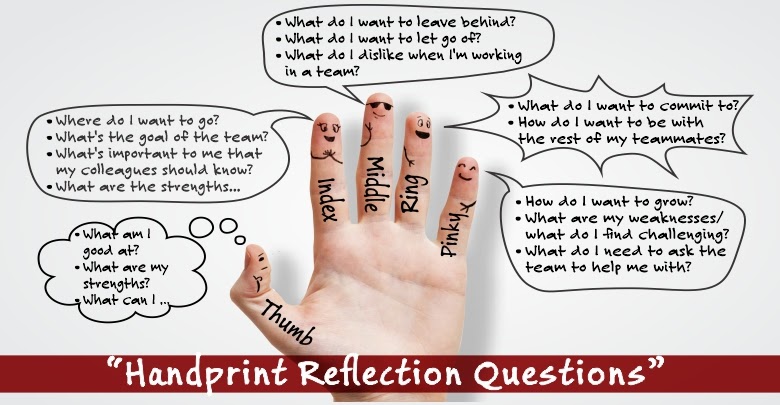Reflection tool for team alignment – The handprint


When working in training teams it is quite crucial to be aligned not only on the goal and the direction but also on the resources, the strengths and the ambitions for personal growth of each team member. Such alignment would create a team culture of authenticity and will enable synergy. The Handprint tool is a simple and creative, self-reflection questionnaire that could catalyze the understanding of three important aspects: the direction in which a team can move forward together, the resources each team member is willing to bring and the personal/professional growth the members could get from working together.
The handprint reflection tool is great to use when teams are being formed. It enables alignment on the task as a team, as well as getting to know better your teammates. The tool consists of reflection which is done on the individual level and then shared, discussed and acknowledged with the rest of the team.
The reason this reflection is called the handprint it’s because its questions follow the fingers and their meaning starting from the thumb, the index finger, the middle finger, the ring finger and the pinky finger. Once one has completed all questions of all 5 fingers the sharing within the team begins.
THUMB
The thumb finger is most commonly used when we approve or consider something good. Resonating with this meaning, in this reflection tool, you and your teammates would use the thumb for the following reflection:
- What am I good at?
- What are my strengths?
- What can I bring into this team/training?
INDEX Finger
The index finger (also known as The Pointer) is commonly used to point to a direction. Therefore, the questions for reflection are the following:
- Where do I want to go?
- What’s the goal of the team and how am I aligned with it?
- What is important to me that my colleagues should know?
- What are the strengths I recognize in my teammates that could complement mine?
MIDDLE finger
The meaning of the middle finger in society is mostly known for flipping people off. It is considered a symbol of contempt in several cultures, especially in the West. Therefore, the reflection questions at this stage are as following:
- What do I want to leave behind?
- What do I want to let go of?
- What do I dislike when working in a team?
RING finger
The ring finger is famous for wearing the wedding ring as a symbol of commitment. Similarly, ask yourself and your teammates, the following questions:
- What do I want to commit to?
- How do I want to be with the rest of my teammates?
PINKY finger
The smallest of all, yet still quite important is the little finger also known as “pinky”. Also known to be used among American children for a “pinky swear” or “pinky promise” as a person wraps one of their pinky fingers around another person’s pinky and makes a promise. Therefore, the questions for reflection at this stage are:
- Where do I want to grow and how would I challenge myself?
- What are my weaknesses/challenges?
- What do I need to ask the team to help me with?
It is highly recommended that you write your answers down and then discuss them with the team. Sharing with each other can build a strong foundation for working together. Understanding the strengths and limitations, but also the growth opportunities within your team can lead to empowerment, prevention of conflict and misunderstandings and thus better performance. This tool can be a great start to establish the team culture that would lead you to success.
Please note that as this is a self-reflection tool and the answers that you would define are subjective. It would be useful to keep a record of the reflection and come back to it in the middle of your project or at the end of it, when maybe new things will come up that you or your teammates notice about yourself. This reflection tool could also be used daily during training for maximum learning.
Reflection questions
- Think about past experiences of teamwork within a trainers team. What was important for success? What was missing?
- Every team has a diversity of resources that its teammates bring with them – how can you become aware of them and use them?
- How might you and your teammates create a team foundation that cultivates team performance and personal growth at the same time?
- In what other ways this reflection could be used?
Exercises
- When forming a training team, use this tool to set the foundation of your team culture
- Keep the record of the reflection and then revise it in the middle/end of the training project
- If needed, evaluate how might this tool help you prevent conflict situations within a team
- Reflect how to have the insights from these reflections helped you know your teammates better and achieve your goal
- Think about your personal commitment to your personal growth from the reflection, how have you performed on that aspect and how has the team helped/challenged you?




